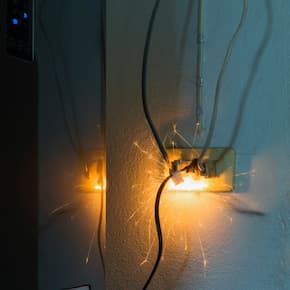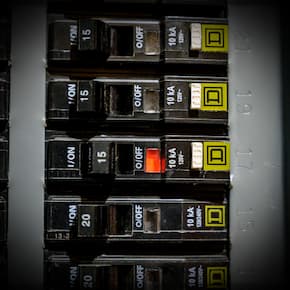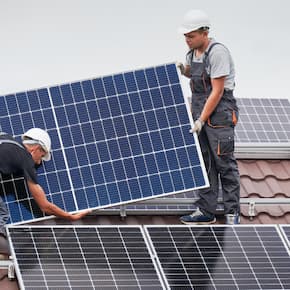How Much Does It Cost to Replace an Electrical Panel?
What’s the Average Cost of an Electrical Panel Upgrade?
Upgrading an electrical panel can averagely cost from $550 to $3,000. However, most people pay around $1,300. This price includes the new panel, materials, and labor. However, the final cost can change based on multiple things, such as the type of your panel, its amperage, and the condition of your existing wiring.
Replacing an electrical panel is not just about cost, it’s also about ensuring the safety and efficiency of your home. An outdated or damaged panel can lead to electrical fires and other costly problems. Therefore, if your electrical panel is not meeting your household’s current energy needs, it’s recommended to replace it as soon as possible.
In the article, we will explain what panel size is the most suitable for your home, what is the best time to upgrade it, and the factors that affect the cost.
Or you can immediately order a free project appraisal by clicking the button below.
When Is It Time to Upgrade an Electrical Panel?
You should think about upgrading your electrical panel if:
- Fuses blow often: If you’re constantly replacing fuses, your panel might be outdated.
- Breakers trip regularly: It means your panel can’t handle your home’s electrical load.
- You add major appliances: If you’re adding high-voltage appliances that consume a lot of electricity, like an HVAC system or a hot tub, you might need more power.
- Your panel is too old: Electrical panels usually need replacement every 20 to 30 years. If your panel is in this age range, it might be time to replace it.
- You renovate your house or build a new one: To meet local building codes and requirements, you may need to upgrade your panel.
- Your home has aluminum wiring: In this case, the wiring can be prone to overheating and fires. Upgrading the panel may be necessary for safety.
What Is the Perfect Electrical Panel Size for Your Home?
When determining the perfect electrical panel size for your home, consider both your current and future electricity needs. The size of an electrical panel is measured in amperes, commonly known as amps. The standard sizes for residential panels are 100, 150, 200, and 400 amps.
For most homes, a 200-amp panel is sufficient. It can handle multiple appliances running simultaneously without tripping the system. However, if your home is smaller and you use fewer high-powered appliances, a 100-amp panel might be adequate. Conversely, if you have a larger home or plan to add major electrical features like a hot tub or an electric car charger, you might need a 400-amp panel.
Determining the perfect electrical panel size for your home is crucial to ensure safety and efficiency. Here are some factors to consider:
The first step is to calculate your home’s power consumption. This includes all electrical appliances, lighting, and HVAC systems. The total wattage of these devices gives you an idea of the electrical load your home requires.
If you plan to add more appliances or expand your home in the future, you should consider a larger panel size. This will accommodate the increased power demand without overloading the system.
Local building codes and safety regulations may dictate the minimum and maximum allowable panel sizes. Always check with a local electrician or the relevant authorities.
The size of your home and the number of electrical circuits also influence the panel size. A small apartment may only need a 100-amp panel, while a large house might require a 200-amp panel.
Pros and Cons of Upgrading Electrical Panels
- Increased capacity: Upgrading your panel can increase the electrical capacity of your home, allowing you to add more appliances or systems without overloading the panel.
- Improved safety: An outdated panel may not handle your current electrical demands, risking overloading and potential fires. Upgrading to a new panel with higher capacity and safety features like AFCI and GFCI breakers minimizes these risks.
- Higher home value: An upgraded electrical panel can increase the value of your home, which can be beneficial if you plan to sell in the future.
- Better energy efficiency: Newer panels are often more energy-efficient, which can lead to lower utility bills.
- Improved Functionality: Modern panels may offer more circuits for better appliance distribution and features like surge protection.
- High upfront cost: Upgrading an electrical panel from 100 to 200 cost can be higher, up to $4,000 depending on how big is an upgrade.
- Potential for disruption: The process of upgrading a panel can cause some disruption to your home, as power may need to be shut off for some time.
- Permitting and inspection: Upgrading a panel usually requires permits and inspections, which can add to the cost and time required for the project.
- Complexity: In some cases, upgrading may require additional work like rewiring or relocating the panel, adding to the cost and complexity.
Factors Affecting the Price to Upgrade an Electrical Panel
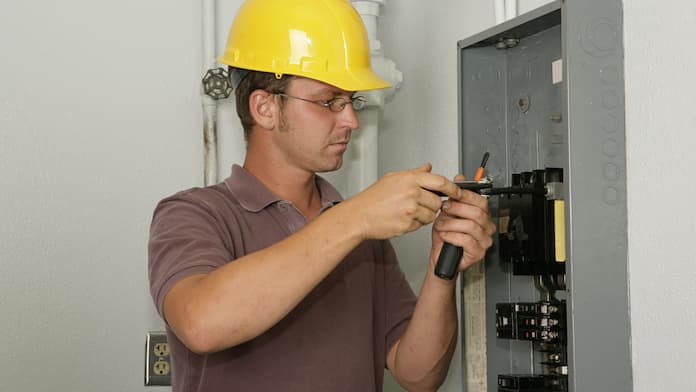
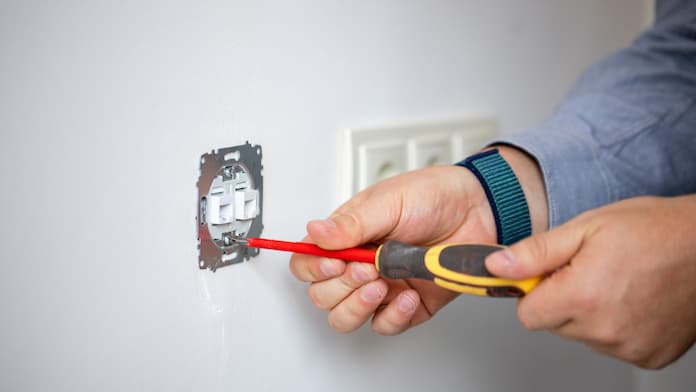
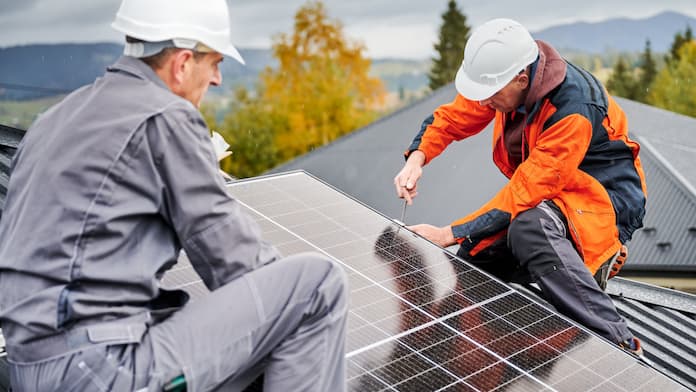
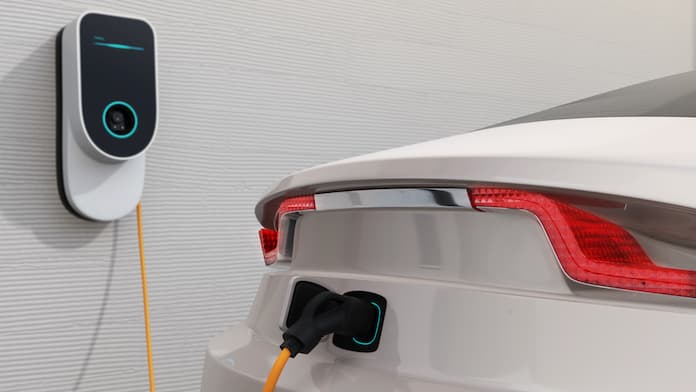
Several factors can affect the cost of upgrading an electrical panel in your home. Here are the key considerations:
- Panel capacity: The larger the amperage capacity, the higher the cost. A jump from 100 amps to 200 amps will be less expensive than going from 200 amps to 400 amps. Expect to pay between $500 and $1,500 for the panel itself, with higher amperage panels costing more.
- Labor costs: Electrician rates can differ depending on your location and the job's complexity. Typically, electricians charge by the hour, with rates ranging from $50 to $150 per hour. A simple replacement might take a day, while a complex job with rewiring could take several days.
- Materials: The price of the panel itself and any additional components like circuit breakers can vary.
- Permits and inspections: Local regulations may require permits and inspections, which add to the overall cost. These can vary widely depending on your location but expect to pay at least $100 to $200.
- Multiple shower spouts
- Complexity of installation: If the upgrade requires extensive rewiring or the replacement of other components, or if there are complications due to the age of the home, the cost will increase. For example, rewiring an electrical panel typically costs $1,500 to $10,000.
- Installation vs. upgrade: A replacement of your existing panel with a new one of similar size is typically the most affordable option. Adding a subpanel to increase capacity or fixing outdated wiring will add labor and materials, raising the cost. Replacing a panel entirely can range from $1,300 to $3,000, while breaker box installation cost is $300 to $350.
- Brand: Some of the well-known brands include Siemens, Square D, and Eaton. Typically, they cost more than unknown brands, but may offer extended warranties or specific features. On average, a Siemens panel may cost between $800 to $2,500, a Square D panel might range from $400 to $1,200, and an Eaton panel could be priced between $500 to $2,000.
How Much Does It Cost to Change an Electrical Panel by Amperage?
Upgrading your home’s electrical panel is an important investment for safety and functionality. Here’s a breakdown of the costs by amperage:
- 100 Amps: Upgrading to a 100-amp panel typically costs between $800 to $1,500. This is suitable for smaller homes with minimal electrical demands.
- 200 Amps: For most homes, a 200-amp panel is recommended, and the cost to upgrade to 200 amps ranges from $1,200 to $3,000. It’s ideal for modern electricity needs.
- 300 Amps: A 300-amp panel is for very large homes or those with high-power requirements, costing about $1,800 to $3,500.
- 400 Amps: The cost to upgrade to a 400-amp panel, usually for homes with extensive electrical equipment, ranges from $2,000 to $4,000.
Is It Cheaper to Replace or Upgrade Your Electrical Panel?
- Replacing an electrical panel: This involves removing the old panel and installing a new one of the same amperage. It’s typically done when the existing panel is faulty or outdated. However, it will not increase your overall electrical capacity. New electrical panel cost ranges from $550 to $2,500.
- Upgrading an electrical panel: Upgrading means increasing the amperage to accommodate more power usage. It’s a good idea if you’re adding major appliances or expanding your home. Upgrading costs more because it often requires additional work like rewiring. The cost to upgrade can vary from $1,300 to $4,000.
Cost to Install an Electrical Panel by Part
The cost to install an electrical panel can vary significantly depending on the specific part being installed:
- Subpanel: The cost to install a subpanel can range from $400 to $1,5001. The price varies depending on its amperage. For example, a 100-amp subpanel might cost between $500 and $1,500, while a 50-amp subpanel could cost between $400 and $600. The cost includes the price of the subpanel itself, which can range from $20 to $350, and the labor costs.
- Main Breaker: The cost to replace the breaker box is typically between $300 to $350. This includes the cost of the breaker itself, which is usually around $15 to $20, and the labor costs. However, the cost can go as high as $280 for 200-amp breakers or even up to $2,000 for a new main breaker box.
- Electric Meter Box: The average cost to update an electrical box is between $500 and $2,100. The cost can vary depending on the meter size, location, installation complexity, and code requirements. The price of the meter box itself can range from $50 to $750.
Cost to Relocate an Electrical Panel
- Distance: Moving the panel a short distance within the same room is generally less expensive than running new wires across long distances or through walls. Expect costs to increase with greater relocation distance.
- Complexity: Relocating to an existing exterior wall might be simpler than creating a new opening in an interior wall or needing to move the meter or service line. More complex jobs will require more time and materials, raising the cost.
- Permits and inspections: Relocating a panel often requires additional permits and inspections to ensure safety. Factor in these costs when budgeting for the project.
DIY Upgrade or Hiring a Pro?
DIY
- Cost savings: Doing the upgrade yourself can save you the cost of labor.
- Learning experience: It can be a great opportunity to learn more about your home’s electrical system.
- Safety risks: Electrical work can be dangerous if not done correctly. Mistakes can lead to electrical shocks, fires, or other hazards.
- Time-consuming: If you’re not experienced, the job can take much longer than it would for a professional.
- Potential for mistakes: Without the proper training and experience, there’s a higher risk of making mistakes that could end up costing more in the long run.
Hiring a Pro
- Expertise: Professionals have the training and experience to do the job safely and correctly.
- Time-efficient: A professional can typically complete the job much faster than a DIYer.
- Peace of mind: Knowing the job has been done correctly can give you peace of mind.
- Cost: Hiring a professional can be more expensive than doing it yourself, especially if the job is complex.
While a DIY upgrade might seem like a good way to save money, the potential safety risks and the chance of making costly mistakes make hiring a professional a worthwhile investment. Always prioritize safety when dealing with electrical work.
How and Where to Hire a Professional Electrician?
Hiring a professional electrician is the best choice for safety and quality when replacing an electrical panel. Professionals are trained to handle electrical systems safely, ensuring the work is up to code, and often comes with a warranty.
To find a pro, start by:
- Checking qualifications: Ensure they have the necessary training, licenses, and insurance.
- Reading reviews: Look for electricians with positive feedback from previous clients.
- Getting estimates: Contact several companies to compare costs and services.
How to Save Money on Electrical Panel Replacement
Upgrading your electrical panel is an important investment, but the cost can add up. Here are some tips to help you reduce the cost to replace an electrical panel:
- Do your homework: Research the average costs of panel replacement in your area. This will help you understand what a fair price looks like and avoid overpaying.
- Get multiple quotes: Don't settle for the first estimate you receive. Contact several licensed electricians in your area and get quotes for the job. This allows you to compare prices and services offered, potentially finding a better deal.
- Plan your project: The more prepared you are, the smoother the project goes. Research typical electrical panel sizes for your home and consider your future electrical needs. This helps electricians provide accurate estimates and avoids surprises during installation.
- Focus on the essentials: Upgrading your panel might tempt you to add unnecessary features or circuits. Stick to what's truly needed for your home's current and future electrical demands. This helps avoid unnecessary costs.
- DIY small tasks: While it’s important to hire a professional for the actual panel replacement, you might be able to handle some small tasks yourself, like preparing the area for work.
Conclusion
Upgrading or replacing an electrical panel is a significant project that can greatly enhance the safety and efficiency of your home’s electrical system. While the cost can vary based on factors, it’s an investment that can lead to long-term savings on energy bills and increase the value of your home.
While it’s possible to save money by doing some tasks yourself, electrical work can be dangerous and should always be done by a licensed professional. Always prioritize safety and quality over cost savings. Your home’s electrical safety is worth it!
Frequently Asked Questions
- Should you upgrade your electrical panel?
Yes, if your current panel is outdated, if you’re experiencing frequent outages, or if you plan to increase your home’s electrical load.
- Is 200 amps enough for a house?
Typically, a 200-amp panel is sufficient for a modern home. However, larger homes or those with high-power appliances may require more.
- Will upgrading your electrical panel improve the electric capacity?
- Yes, upgrading your electrical panel can increase the electrical capacity of your home, allowing you to add more appliances or systems without overloading the panel.
- Can I do everything myself?
Electrical work is complex and can be dangerous. It’s recommended to hire a professional electrician for safety and compliance with local codes.
- How often should you upgrade your electrical panel?
There’s no set timeframe but consider upgrading if your panel is over 25 years old or doesn’t meet your electrical needs.
- How can I know that my electrical panel is overloaded?
- Signs of an overloaded panel include flickering lights, frequent breaker trips, and appliances not operating at full power.
- How different are 100-amp and 200-amp panels?
- A 200-amp panel can supply more power and support more circuits than a 100-amp panel, making it better suited for modern homes with higher energy demands.

